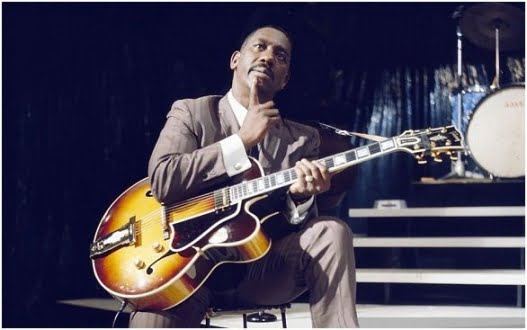06.03. – Happy Birthday !!! Born in Indianapolis, Indiana, United States (where he also died of a heart attack in 1968), Montgomery came from a musical family, in which his brothers, Monk (string bass and electric bass) and Buddy (vibraphone, and piano), were jazz performers. Although Wes was not skilled at reading music, he could learn complex melodies and riffs by ear. Montgomery started learning guitar in his late teens, listening to and learning recordings of his idol, the guitarist Charlie Christian.
Along with the use of octaves (playing the same note on two strings one octave apart) for which he is widely known, Montgomery was also an excellent “single-line” or “single-note” player, and was very influential in the use of block chords in his solos. His playing on the jazz standard “Lover Man” is an example of his single-note, octave and block chord soloing. (”Lover Man” appears on the Fantasy album THE MONTGOMERY BROTHERS.)
Instead of using a guitar pick, Montgomery plucked the strings with the fleshy part of his thumb, using downstrokes for single notes and a combination of upstrokes and downstrokes for chords and octaves. This technique enabled him to get a mellow, expressive tone from his guitar. George Benson, in the liner notes of the Ultimate Wes Montgomery album, wrote that “Wes had a corn on his thumb, which gave his sound that point. He would get one sound for the soft parts, and then that point by using the corn. That’s why no one will ever match Wes. And his thumb was double- jointed. He could bend it all the way back to touch his wrist, which he would do to shock people.”
He generally played a Gibson L-5CES guitar. In his later years he played one of two guitars that Gibson custom made for him. In his early years, Montgomery had a tube amp, often a Fender. In his later years he played a Standel.
Montgomery toured with vibraphonist Lionel Hampton’s orchestra from July 1948 to January 1950, and can be heard on recordings from this period. Montgomery then returned to Indianapolis and did not record again until December 1957 (save for one session in 1955), when he took part in a session that included his brothers Monk and Buddy, as well as trumpeter Freddie Hubbard, who made his recording debut with Montgomery. Most of the recordings made by Montgomery and his brothers from 1957-1959 were released on the Pacific Jazz label.
From 1959 Montgomery was signed to the Riverside Records label, and remained there until late 1963, just before the company went bankrupt. The recordings made during this period are widely considered by fans and jazz historians to be Montgomery’s best and most influential. Two sessions in January 1960 yielded The Incredible Jazz Guitar of Wes Montgomery, which was recorded as a quartet with pianist Tommy Flanagan, bassist Percy Heath and drummer Albert “Tootie” Heath. The album featured one of Montgomery’s most well-known compositions, “Four on Six.”
Almost all of Montgomery’s output on Riverside featured the guitarist in a small group setting, usually a quartet or quintet, playing a mixture of hard- swinging uptempo jazz numbers and quiet ballads. In 1964 Montgomery moved to Verve Records for two years. His stay at Verve yielded a number of albums where he was featured with an orchestra, and during this period Montgomery’s music started to shift in to the territory of pop music. One notable exception is 1965’s Smokin’ at the Half Note, which showcased two memorable appearances at the famous New York City club with the Wynton Kelly Trio. Wes continued to play outstanding live jazz guitar, as evidenced by surviving audio and video recordings from his 1965 tour of Europe.
As a considered founder of the Smooth Jazz school the album “Bumpin’” (1965) represents a model from which many modern recording are derived. In it, a full orchestral type of scoring goes beyond the artist’s own ability to riff creating a wholistic concept of music and of Jazz. Longer clips from all of the tracks tracks on “Bumpin’” and other Wes Montgomery albums are found on Verve Records website.
By the time Montgomery released his first album for A&M Records, he had seemingly totally abandoned the straightforward jazz of his earlier career for the more lucrative pop market. The three albums released during his A&M period (1967-68) feature orchestral renditions of famous pop songs (”Scarborough Fair,” “I Say a Little Prayer for You,” “Eleanor Rigby,” etc.) with Montgomery reciting the melody with his guitar. While these records were the most commercially successful of his career, they are now poorly regarded by some fans and critics.
Montgomery’s home town of Indianapolis has named a park in his honor.
Many jazz and rock guitarists today list Montgomery among their influences including: Carlos Santana, Jimi Hendrix, Pat Martino, Lee Ritenour, Pat Metheny, George Benson, Pete Smyser, Chris Standring, Eric Johnson, Yoshiaki Miyanoue and Joe Satriani.
By some accounts, Montgomery has been the most influential jazz guitarist of all time, whose style has transcended into other forms of music, including Rock ‘n’ Roll, Soul, and Rhythm and Blues.[citation needed] Many songwriters and composers have written musical tributes to him, including Stevie Wonder and Eric Johnson.







More Stories
CD review: George Benson – Dreams Do Come True: When George Benson Meets Robert Farnon – 2024: Video, CD cover
The band was tight as ever. The Warren Haynes Band cuts loose: Video, Photos
Interview with Alvin Queen: Feeling Good – I heard these tunes played by … Video, new CD cover, Photos